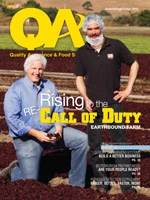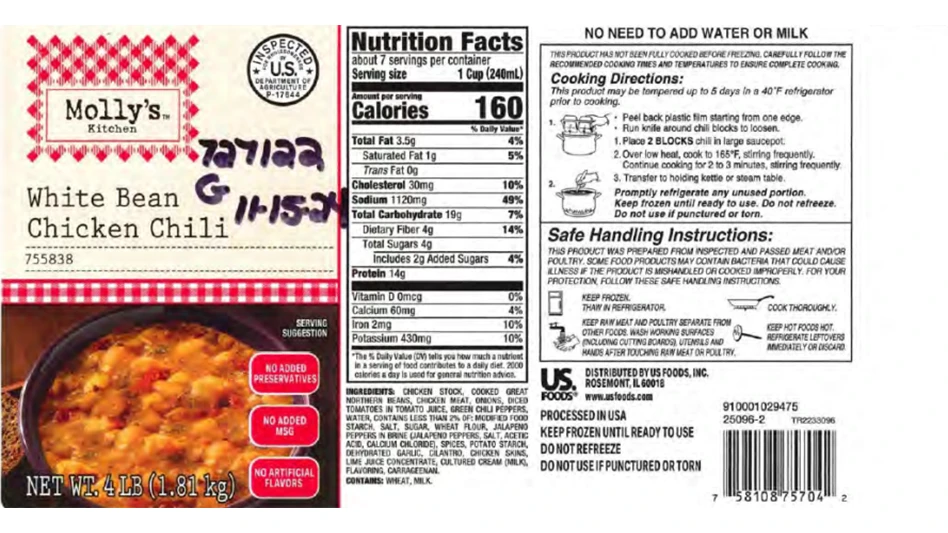As pathogen-related food recalls continue to gain increased regulatory, consumer and media attention, detection testing is following suit. Because risk factors vary greatly among the many market segments of the food industry, there is also a great deal of variation in testing and in definition of efficacy and efficiency, said Michael Wendorf, Neogen market development manager for pathogen diagnostics. However, Wendorf added, what is being seen across the industry is a greater focus on product hold after testing to prevent positives from getting into the consumer retail stream. For this reason the industry wants bigger, better, faster, more. That is, Wendorf said, “What is being looked for by industry is larger sample sizes without sacrificing accuracy or time to results.”
Faster, said Robert Hird, chief technology officer for FluoroVei, is generally seen by plant personnel as “what can be done in one work shift. “That is a true rapid test,” Hird said. “Anything longer than that, the industry doesn’t consider rapid.”
The Trends. Stan Bailey, director of scientific affairs for bioMerieux, agreed that rapidity of testing is a current and enduring trend. “What we’re seeing is a trend that has been ongoing for many years to speed the time of detection to as close to real time as possible.” This is especially true for E. coli O157:H7, he said. For Salmonella and Listeria, the trend is to next-day assays.
But while rapid results are important, accuracy is even more so, Bailey added. “To me it is a given—no matter what we’re doing in trying to improve pathogen detection, you can’t move forward until you have an equal or better sensitivity and specificity.” Other trends being seen are:
- Simplification. Testing companies are working to simplify methods that can be cumbersome for plant personnel. “We’re trying to streamline all our assays to minimum time,” Bailey said, adding, “Every time a person touches an assay, there is an opportunity for error. So we are trying to reduce the number of touches.”
- Automation. The current economy is requiring all industries to do more with less, and there is no exception for pathogen testing in the food industry. “Everybody is being asked to do more sampling, more testing with fewer resources, so how does one approach that?” Bailey asked, then answered, “The only way is the development of more simple, more automated assays.”
- Product Profile. A driving trend Bailey has seen is “the desire to have a better understanding of a product’s microbial make-up so you can know if your process is under control.” By having an accurate profile of the product in its ideal state, a processor can better detect if or when anything is out of specification or adulterated.
In-house vs. third-party. While there seems to be no evolving trend in lab site, “what is critical is that one have proper controls built into the approach whether in-house or third party,” Bailey said. In any lab, it is critical to use the appropriate technology and techniques; have the ability to use the tests as designed and validated for the metrics; and document everything.
Whether using an in-house or third-party lab, it is the manufacturer who is ultimately culpable for the results. “It is totally dependent on the manufacturer to select a lab based on use of the proper techniques and to verify that they are doing so,” said Tim Wheeler, bioMerieux marketing manager of biofood. “The manufacturer of the food is the ultimate responsible party. ”
The Regulatory Climate. The industry is in the midst of reassessment of food safety processes, practices and accountabilities by regulatory agencies, which is impacting all facets of testing.
“The food industry is under a lot more scrutiny today than it was five or 10 years ago.“ Wendorf said. “We are seeing a shift in regulatory influence on driving of testing.” Not only are the agencies requiring more specific testing, there is an increasingly complex range of accountabilities between the FDA and USDA “which further blurs the lines of jurisdiction” he said.
In addition, the USDA is assessing the definition and qualifications of validation, particularly “validation of intervention strategies that has added an extra tier of scrutiny to pathogenic platforms,” he said.
Seeing that the government agencies are seeking to require more Salmonella testing, Hird said, the industry wants to know what is available and what is on the horizon. “They know it’s coming; they want to be ready for it.”
Regulation is also being sought by USDA in relation to E. coli, as it looks at a larger group of shigatoxin-producing strains and six O types in addition to O157, said Jim Stave, senior research fellow with SDIX. Because such regulation would add these strains as adulterants, “tests that can detect these will be highly scrutinized.”
The federal agencies are continuing to add layers in food safety that were never there before, Hird said, citing the Federal Register as just one example. “I think the FDA is tired of getting hammered every time there’s a food outbreak that they didn’t catch.
“So we can expect there to continue to be more testing requirements.” Within five years, Hird projected, the entire industry will be mandated to do more testing. “In the next five years, it will be a safer food chain,” he said.
Thus, it is critical that testing companies understand, and help their customers understand, these accountabilities, and provide compliant testing. “It reinforces that vendors need to be in concert with what the producer wants, but also in step with what regulators want,” Wendorf said.
In fact, Stave said, the industry needs to understand the difference in purpose and applicable testing. For regulators, he said, the purpose is to test for detection of regulated adulterants in a food or plant environment. For producers, however, the purpose should be to test so as to prevent adulterants from entering the process, while also meeting regulatory and public health needs.
False Positive or Red Flag?
“Food safety is being negatively impacted by the use of the phrase ‘false positive,’” said Jim Stave, senior research fellow for Strategic Diagnostics (SDIX).
Say, for example, a producer is testing a product for E. coli. A test is run for E. coli O157 and comes up positive. So the producer holds the product while a more specific O157:H7 test is run. When that test comes up negative, the producer breathes a sigh of relief while complaining about “false positives,” ships the product and moves on.
But, Stave said, “We say, ‘No wait!’“ If you have O157—where did it come from? It shouldn’t be there. Whatever is allowing O157 to be there is also allowing H7 to be there.
You haven’t detected it yet, but it is a warning signal that you need to do something proactively to reduce O157 before the next test says, ‘Yes, you have H7.’ Then you do have an adulterant, you do have a recall, and FDA is involved.
“It’s a shame that industry and the government say that that first test was a false positive,” Stave said. The test was not falsely positive, it correctly identified what it was intended to detect.
Differing Perspectives. What is important to understand, Stave clarified, is that the purpose of testing by a federal agency is—or should be—different than that of industry. FDA’s intention is to find any contamination by specific adulterants, so its test methods should be specific to that. However, a plant’s purpose should be to prevent that contamination, and, Stave said, “The way to do that is to use a screening test for the indicator organism that occurs at a higher rate.”
If an indicator organism is present, it provides a red flag so the processor can take steps to remediate the deficiency prior to the adulterant being detected, he said. “If O157 is present in the process, it is only a matter of time until you have O157:H7.”
Testing for the indicator organism is also helpful to determine a negative. Only one to two percent of the samples will generally come up positive for O157, Stave said, which means 98 percent is negative, so no further testing is needed. “If O157 is not there, that absolutely means that O157:H7 is not there.”
“This approach allows the processor to prevent contamination by the adulterant and thereby reduces risk of disease; reduces disease in the population; reduces death from disease—and protects the brand.”
If a processor tests only with adulterant specific methods, it will have fewer positives. But when a positive does show up, “that positive is for the adulterant, and you are stuck. It’s too late to take any preventive action,” he said. “You now have a recall, and your brand just took a hit.”
It is a distinction that makes the difference between interpreting a positive result of a less specific test as an early warning signal or as a false positive. (See False Positive or Red Flag, above.)
Where Do We Go From Here? “We’re always looking to optimize current chemistry or integrate novel chemistry,” Wendorf said. The ideal is direct assay of a sample: detecting pathogens without enrichment. “But it is just not practical.”
“The industry would like to hold up a piece of meat and see bacteria if it is there, but we will always need some grow up, especially if there are only a few bacteria present,” Hird said. But if a result can be attained in one work shift, so product does not have to be held, processors are happy, he said.
“Theoretically, some technology should be able to tell immediately if any pathogen is present,” Bailey said. “By practical reality, the chemical components of the foods themselves all come into play.” The limiting factor is not the technical ability to detect low levels, he said, it is getting them out of the food to where they can be detected.
Wendorf expects that the industry will begin to see platforms capable of detecting more targets, such as more than one strain of E. coli or Salmonella. Because there are potential platforms that haven’t yet hit their full capabilities, he said, it is a practical goal. “And that could change the industry.”

Explore the October 2010 Issue
Check out more from this issue and find your next story to read.
Latest from Quality Assurance & Food Safety
- Boston Sword & Tuna Protects Seafood Safety with Mettler-Toledo Metal Detectors
- IFT Releases New Resources to Aid Food and Beverage Industry in Sugar Reduction
- Yum! Brands CEO David Gibbs to Retire in 2026
- Penn State Extension Offers Short Course on Food Microbiology and Safety for Food Plant Workers
- Johnsonville Recalls Cheddar Bratwurst Due to Possible Plastic Contamination
- Cabot Creamery Butter Recalled Due to Possible Fecal Contamination
- USDA Delays Salmonella Testing Program for Breaded Stuffed Chicken
- FDA Extends Comment Period on Poppy Seeds to June 16





